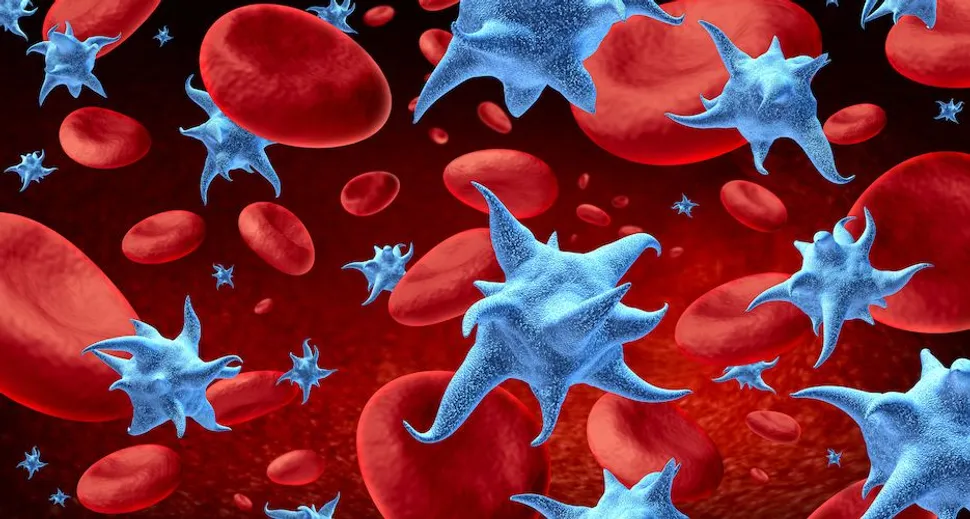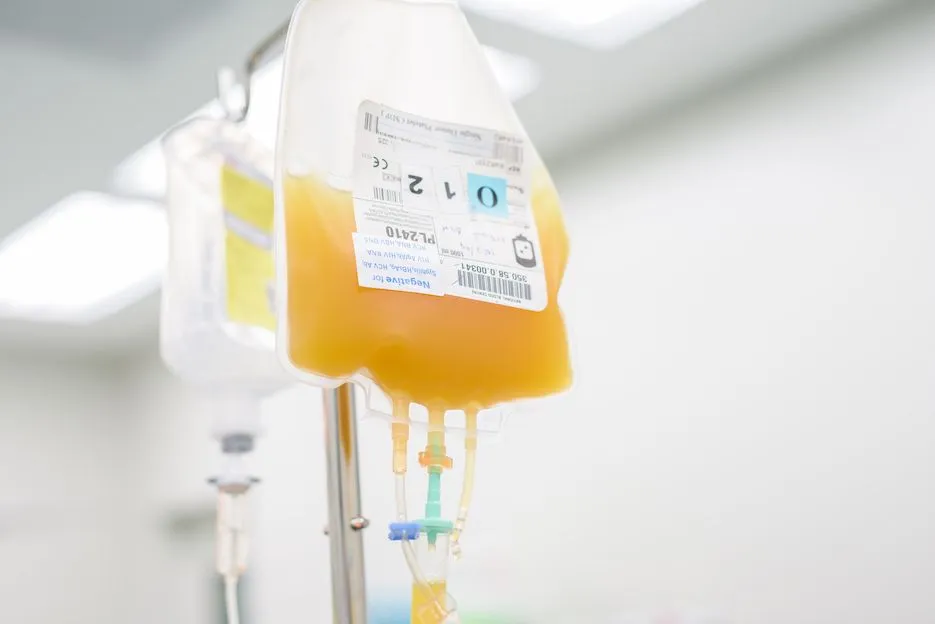Managing Low Platelet Levels in Blood Cancers

Blood cancer patients are frequently diagnosed with low amounts of platelets or thrombocytopenia, often causing side effects such as easy bleeding and bruising. A treatment called a platelet transfusion may help improve this condition.
What is Thrombocytopenia?
Platelets, or thrombocytes, are critical components of the blood clotting system. They combine to form clots to stop bleeding and facilitate repair in damaged areas of the body. The average range values of platelets in the blood may vary from 150,000 cells to 400,000 cells per microliter of blood.
Thrombocytopenia is a medical condition characterized by abnormally low amounts of platelets in the blood (less than 150,000 platelets per microliter of blood). Thrombocytopenia levels include (thresholds might vary slightly between laboratories):
- Mild thrombocytopenia
- Platelet level: 101,000 to 150,000 cells per microliter of blood
- Moderate thrombocytopenia
- Platelet level: 51,000 to 100,000 cells per microliter of blood
- Severe thrombocytopenia
- Platelet level: 21,000 to 51,000 cells per microliter of blood
- Very severe or life-threatening thrombocytopenia
- Platelet level: 20,000 or less cells per microliter of blood
In blood cancer patients and those undergoing a stem cell transplant, platelet transfusions are considered when platelet levels are below 100,000 cells per microliter of blood.
How Did My Platelet Level Become Low?
Blood cancers disrupt the normal production of blood cells in the bone marrow, where platelets are produced. A decrease in platelet levels is a common complication caused by impaired bone marrow function or, more frequently, due to specific therapies that limit platelet function or target cells involved in making platelets. Thrombocytopenia is a common side effect of most chemotherapeutic agents, immunotherapies, and novel medicines such as bispecific antibodies and CAR T cells.
What are the Side Effects of Having a Low Platelet Level?
A low platelet level can lead to various side effects, primarily associated with the inability to clot correctly. Patients may notice increased bruising, bleeding gums, nosebleeds, and prolonged bleeding from cuts. Severe thrombocytopenia can lead to dangerous internal bleeding, including in vital organs. Managing platelet levels is integral to your overall care strategy for blood cancer patients to minimize these risks. One way to increase platelet levels is through platelet transfusions.
What is a Platelet Transfusion?

A platelet transfusion is a medical treatment in which platelets are infused into a patient's bloodstream to aid in clotting. It is typically used for those with low platelet levels (moderate thrombocytopenia or worse), platelet dysfunction, or severe active bleeding.
The platelets used in transfusions are usually collected from donors through a process called apheresis. In this process, blood is drawn from the donor and passed through a machine, separating the platelets while returning other blood components to the donor. This method allows for collecting a large number of platelets from a single donation, making it highly effective for gathering sufficient platelets for therapeutic use.
What to Expect When Receiving a Platelet Transfusion:
- You’ll first get a compatibility test via a blood sample to ensure the donor platelets match your blood type and are safe to transfuse.
- Once compatibility is confirmed, the platelets are administered intravenously in a clinical setting like a hospital or outpatient clinic, which usually takes less than 30 minutes.
- During the transfusion, medical staff will closely monitor you to identify possible side effects, such as fever, chills, or allergic responses. If you experience side effects, your care team will administer supportive measures.
- After the transfusion, your platelet level will be assessed to determine the effectiveness of the treatment.
In conclusion, blood cancer patients experiencing thrombocytopenia may face health challenges due to their low platelet levels, which can result in bleeding and bruising. Under certain conditions, platelet transfusions are a treatment option to restore platelet levels and improve clotting function, enhancing patients’ overall health and quality of life.
Sources:
Blood cancer patients are frequently diagnosed with low amounts of platelets or thrombocytopenia, often causing side effects such as easy bleeding and bruising. A treatment called a platelet transfusion may help improve this condition.
What is Thrombocytopenia?
Platelets, or thrombocytes, are critical components of the blood clotting system. They combine to form clots to stop bleeding and facilitate repair in damaged areas of the body. The average range values of platelets in the blood may vary from 150,000 cells to 400,000 cells per microliter of blood.
Thrombocytopenia is a medical condition characterized by abnormally low amounts of platelets in the blood (less than 150,000 platelets per microliter of blood). Thrombocytopenia levels include (thresholds might vary slightly between laboratories):
- Mild thrombocytopenia
- Platelet level: 101,000 to 150,000 cells per microliter of blood
- Moderate thrombocytopenia
- Platelet level: 51,000 to 100,000 cells per microliter of blood
- Severe thrombocytopenia
- Platelet level: 21,000 to 51,000 cells per microliter of blood
- Very severe or life-threatening thrombocytopenia
- Platelet level: 20,000 or less cells per microliter of blood
In blood cancer patients and those undergoing a stem cell transplant, platelet transfusions are considered when platelet levels are below 100,000 cells per microliter of blood.
How Did My Platelet Level Become Low?
Blood cancers disrupt the normal production of blood cells in the bone marrow, where platelets are produced. A decrease in platelet levels is a common complication caused by impaired bone marrow function or, more frequently, due to specific therapies that limit platelet function or target cells involved in making platelets. Thrombocytopenia is a common side effect of most chemotherapeutic agents, immunotherapies, and novel medicines such as bispecific antibodies and CAR T cells.
What are the Side Effects of Having a Low Platelet Level?
A low platelet level can lead to various side effects, primarily associated with the inability to clot correctly. Patients may notice increased bruising, bleeding gums, nosebleeds, and prolonged bleeding from cuts. Severe thrombocytopenia can lead to dangerous internal bleeding, including in vital organs. Managing platelet levels is integral to your overall care strategy for blood cancer patients to minimize these risks. One way to increase platelet levels is through platelet transfusions.
What is a Platelet Transfusion?

A platelet transfusion is a medical treatment in which platelets are infused into a patient's bloodstream to aid in clotting. It is typically used for those with low platelet levels (moderate thrombocytopenia or worse), platelet dysfunction, or severe active bleeding.
The platelets used in transfusions are usually collected from donors through a process called apheresis. In this process, blood is drawn from the donor and passed through a machine, separating the platelets while returning other blood components to the donor. This method allows for collecting a large number of platelets from a single donation, making it highly effective for gathering sufficient platelets for therapeutic use.
What to Expect When Receiving a Platelet Transfusion:
- You’ll first get a compatibility test via a blood sample to ensure the donor platelets match your blood type and are safe to transfuse.
- Once compatibility is confirmed, the platelets are administered intravenously in a clinical setting like a hospital or outpatient clinic, which usually takes less than 30 minutes.
- During the transfusion, medical staff will closely monitor you to identify possible side effects, such as fever, chills, or allergic responses. If you experience side effects, your care team will administer supportive measures.
- After the transfusion, your platelet level will be assessed to determine the effectiveness of the treatment.
In conclusion, blood cancer patients experiencing thrombocytopenia may face health challenges due to their low platelet levels, which can result in bleeding and bruising. Under certain conditions, platelet transfusions are a treatment option to restore platelet levels and improve clotting function, enhancing patients’ overall health and quality of life.
Sources:

about the author
Megan Heaps
Megan joined HealthTree in 2022. She enjoys helping patients and their care partners understand the various aspects of the cancer. This understanding enables them to better advocate for themselves and improve their treatment outcomes.
More on Navigating Your Health
Trending Articles
Get the Latest Blood Cancer Updates, Delivered to You.
By subscribing to the HealthTree newsletter, you'll receive the latest research, treatment updates, and expert insights to help you navigate your health.
Together we care.
Together we cure.
3x Faster.












